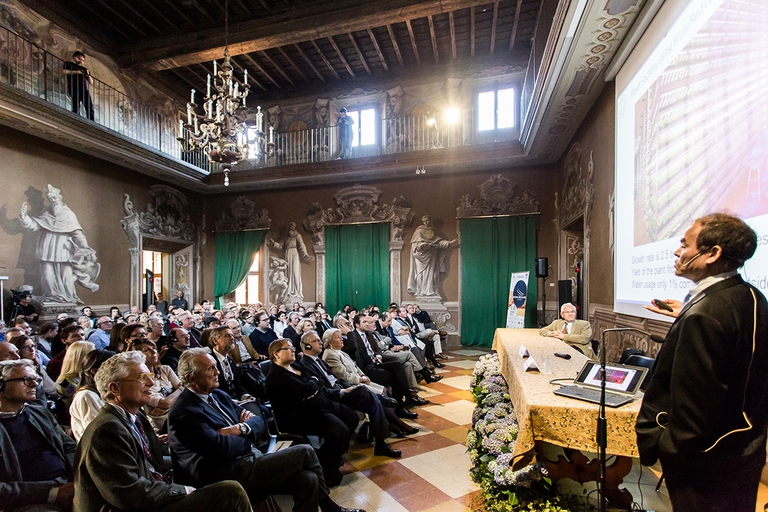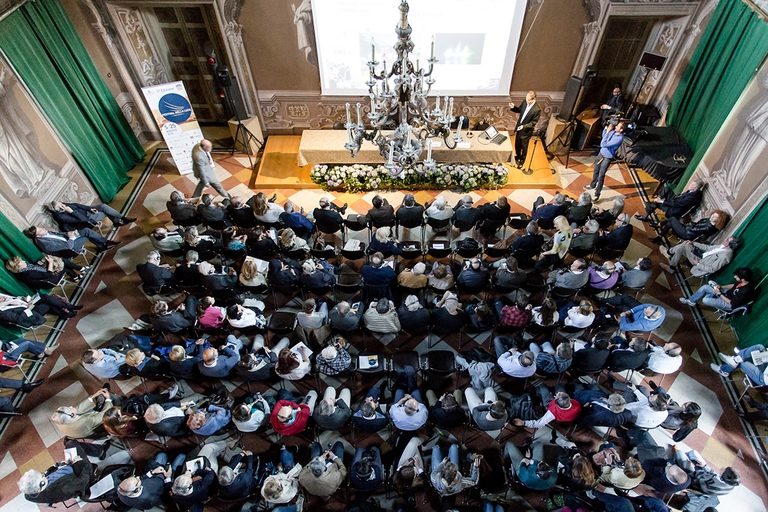
A group of experts in Tokyo suggested pouring radioactive water from Fukushima into the open sea. A marine biochemist explains the consequences of this absurd decision.
Shuji Nakamura, premio Nobel per la Fisica, è stato a Como in occasione del Festival della Luce. L’inventore dei Led ha svelato a LifeGate come sarà la luce e l’energia del futuro.
Shuji Nakamura, along with Isamu Akasaki and Hiroshi Amano, invented blue LEDs (blue light-emitting diodes) in 1993 and, 21 years later, was awarded the Nobel Prize for Physics. That discovery turned out to be a brilliant success, as LEDs are able to increase energy efficiency and contribute to cutting CO2, which is responsible for climate change. Nakamura attended the inauguration of the Festival della Luce on the 5th of May in Como, Italy. In this interview, he talks about how his products became well-known all over the world and how he reckons the energy and lighting industry will develop.
Let’s begin with the award you received two years ago for having invented LEDs. What did you experience when you found out you had become a Nobel Prize winner?
I invented LEDs in 1993. After that, Japanese mass media would come to my house one day before the Nobel Prize announcement, every year since 1993. Mass media was long expecting it. So I wasn’t surprised. However, nothing happened for twenty years and I started to think I wouldn’t win. In the end, I wasn’t so sure it would happen.
It has taken over twenty years for LEDs to become of common use, and they’re still not sufficiently widespread. Given the temporal gap between science and consumption, what is research in the lighting sector focused on today and that will probably become the standard in 20 years?
I think LEDs caught on slowly globally because of the colour of the light, which was initially cold white. And European people were used to warm white, so nobody liked it. But now LEDs use warm light as well and they’ve become popular and widespread all over the world. I think that they’ll remain the most efficient lighting system in the next twenty years. LEDs and conventional incandescent light bulbs are quite the same, but LEDs’ consumption is a tenth. Moreover, LEDs can last up to fifteen years and help save materials and resources. In general terms, I expect laser lighting to be the form of lighting of the future, but it is still at an early stage and I think it’ll be launched on the market as late as ten years from now.
Energy efficiency and renewable energy go hand in hand. Often when a house is transformed into a passive one, the lighting system is changed and solar panels are installed. What type of energy will emancipate us from fossil fuels, definitively?
I think hydrogen. Solar, wind and biomass energy are great technologies but have a big problem: there’s no way of storing energy. Well, there is, but only in the short run. Their limit is that when you generate energy you have to spend that energy. Instead, the energy produced with hydrogen can be stored, like gas, for longer periods of time. Hydrogen has a huge potential as an energy resource.
Is hydrogen already common in Japan?
Car manufacturers like Toyota have launched new hydrogen-powered vehicles. Moreover, hydrogen is used in houses, but it’s expensive, thus not so popular.
What role do LEDs play in bettering the living conditions of the 1.5 billion people who still don’t have constant access to electricity?
The regions that have no access to electricity usually use oil lamps. The problem is that those lamps depend on kerosene, and oil is very expensive for developing countries. Each lamp needs to be recharged with oil and costs about 150 dollars per year. But now, there’s a new opportunity: LED lamps. These use batteries charged by solar cells during the daytime. This system is affordable and clean. A LED lamp costs about ten dollars and lasts three years, meaning it costs three dollars a year. If it lasts more, it would be almost free as the cost would be negligible.
What stage has their dissemination in industrialised nations reached, instead?
These countries are switching, gradually, to LEDs. In the United States their dissemination is around 5-10 per cent, while Japan exceeds 50 per cent. In Japan, it is due to the earthquake and Fukushima nuclear disaster, which led the government to shut down all nuclear plants. The country went through an energy crisis. We hardly had energy. So the Japanese government encouraged the population to use more efficient lighting systems. Nowadays, many governments are educating the general public on using LEDs, as people often make their choices according to affordability. Conventional incandescent light bulbs are cheaper, but they last less. On the contrary, LEDs may have a higher initial cost, but they’re more worthwhile in the long period. It’s a payback system.
Siamo anche su WhatsApp. Segui il canale ufficiale LifeGate per restare aggiornata, aggiornato sulle ultime notizie e sulle nostre attività.
![]()
Quest'opera è distribuita con Licenza Creative Commons Attribuzione - Non commerciale - Non opere derivate 4.0 Internazionale.
A group of experts in Tokyo suggested pouring radioactive water from Fukushima into the open sea. A marine biochemist explains the consequences of this absurd decision.
A federal court in Washington, D.C. has struck down the Dakota Access Pipeline, following years of campaigning by the Standing Rock Sioux tribe.
The Scottish island of Eigg is self-sufficient for its energy needs, relying almost entirely on renewable sources, especially thanks to a coordinated community effort.
President Magufuli in unmovable in going ahead with the Stiegler’s Gorge dam despite conservationists’ warnings of the damage it will cause the Selous Game Reserve’s ecosystem and wildlife.
A large dam along the Luangwa River in Zambia would have posed a serious risk to local people and wildlife, leading hundreds of thousands to oppose it. A call to which the government responded by halting plans to build it.
The first one megawatt solar power plant in the Chernobyl exclusion zone has become operational. This is the first step in a renewable energy development project promoted by the Ukrainian government in the area.
A tanker exploded at a gas and petrol station in Nigeria’s Nasarawa state on the 10th of September, killing 35 people and leaving some burned beyond recognition; 3 citizens had several spine and brain injuries, 2 of them are still on Intesive Care Units. Fela Habila , a local singer, is now stable and out of danger but
The largest tidal power plant in the world will be built in the Larantuka Straits. It will serve 100,000 people and help overcome some of the challenges of energy provision in Indonesia.
Robben Island’s solar energy micro-grid project will produce almost one million kilowatt hours of electricity annually, significantly reducing the cost and impact of buying diesel.









